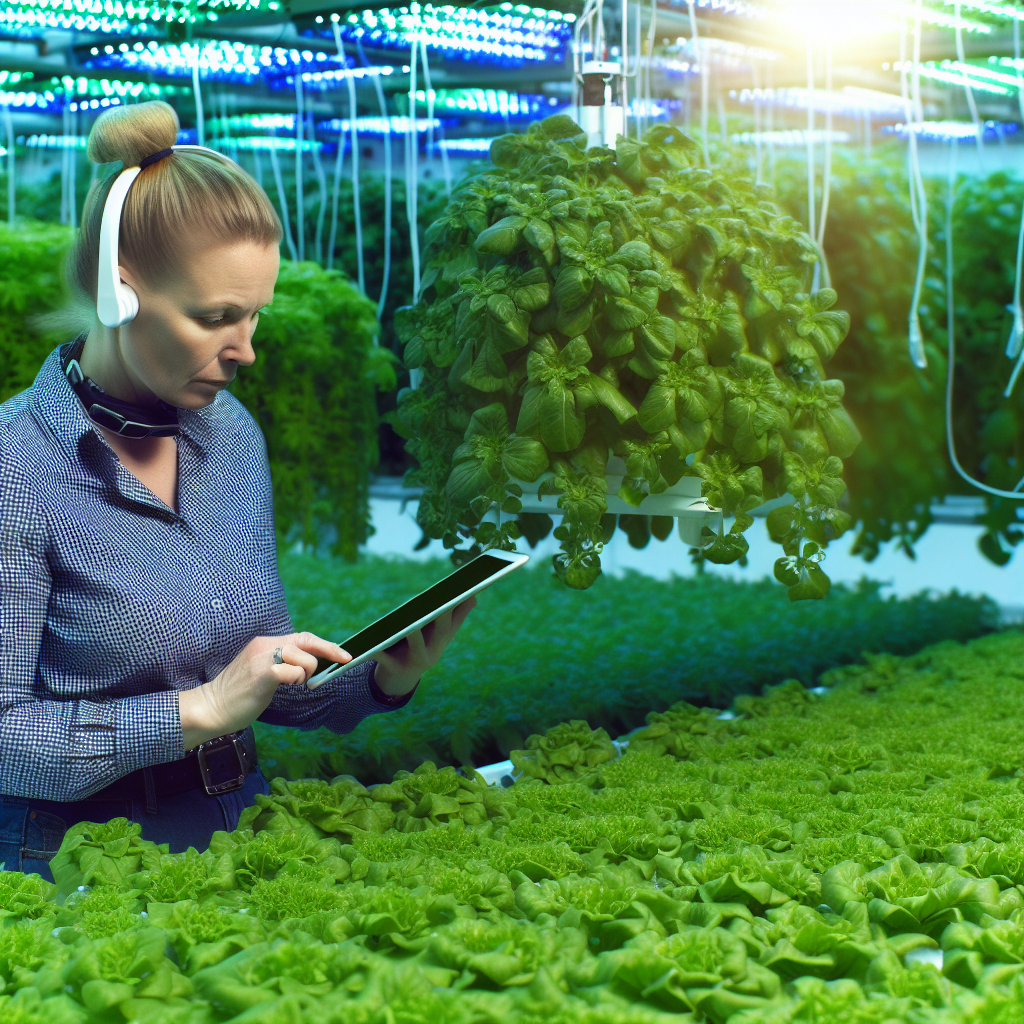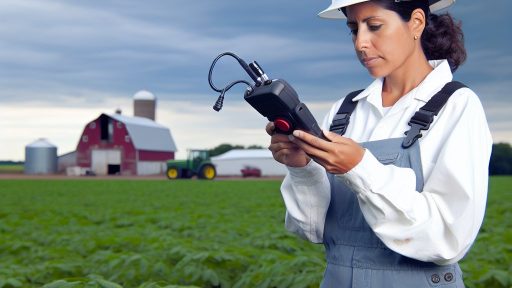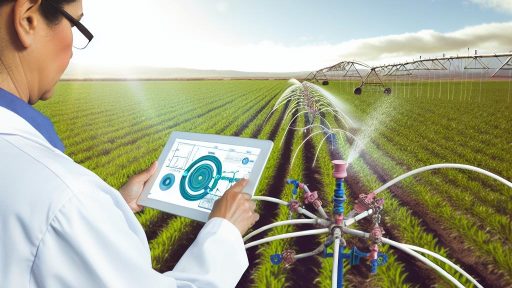Introduction to Hydroponic Farming and Its Benefits
Understanding Hydroponics
Hydroponics is a method of growing plants without soil.
Instead, it uses nutrient-rich water solutions.
This technique promotes faster plant growth compared to traditional farming.
Benefits of Hydroponic Farming
Hydroponic systems provide numerous advantages for farmers.
Firstly, they utilize space more efficiently.
Vertical gardens save land while maximizing productivity.
Next, hydroponics reduces water usage significantly.
Plants receive just the right amount of water needed.
Reduction of Pesticides
Farmers using hydroponics can minimize pesticide usage.
This method often leads to healthier plants and better yields.
Additionally, hydroponic farming limits exposure to pests.
Quality and Freshness
Fresh produce is crucial for health-conscious consumers.
Hydroponically grown vegetables and fruits can be harvested year-round.
This approach ensures consistent supply in local markets.
Sustainability Factor
Hydroponics promotes sustainable farming practices.
Transform Your Agribusiness
Unlock your farm's potential with expert advice tailored to your needs. Get actionable steps that drive real results.
Get StartedIt reduces the carbon footprint of traditional agriculture.
Moreover, it lessens the impact on land degradation.
Tech Integration
Automation plays a key role in hydroponic farming.
It simplifies monitoring and managing crops efficiently.
Smart technology helps optimize growth conditions.
Overview of Automation in Farming
The Role of Technology
Automation technology transforms farming practices around the world.
It allows farmers to efficiently manage their crops.
Furthermore, it increases productivity and reduces labor costs.
Technologies like sensors and drones play a crucial role.
These tools monitor crop health and environmental conditions.
Moreover, they provide real-time data for better decision-making.
Trends in Farm Automation
Many farms are adopting smart irrigation systems.
These systems optimize water usage and conserve resources.
Additionally, robotic harvesters are gaining popularity.
They can efficiently gather crops, reducing manual labor.
Furthermore, AI-driven analytics help optimize planting schedules.
Farmers use these insights to maximize yields.
Benefits of Automating Hydroponic Farms
Hydroponic systems benefit greatly from automation.
Automation ensures consistent nutrient delivery to plants.
This leads to faster growth rates and improved crop quality.
Additionally, it minimizes human error in farming operations.
Automated monitoring systems can detect issues early.
As a result, farmers can take timely action to prevent loss.
Challenges of Implementing Automation
Despite its advantages, automation presents challenges.
Showcase Your Farming Business
Publish your professional farming services profile on our blog for a one-time fee of $200 and reach a dedicated audience of farmers and agribusiness owners.
Publish Your ProfileThe initial investment for technology can be significant.
Furthermore, farmers must learn new skills to operate systems.
Reliability and maintenance of equipment are also concerns.
Farmers need to choose trustworthy technology providers.
Overall, weighing costs against benefits is essential.
Key Components of an Automated Hydroponic System
Essential Hardware
An automated hydroponic system relies on key hardware components.
These components ensure efficient nutrient delivery and environmental regulation.
Common hardware elements include pumps, reservoirs, and grow lights.
Each contributes uniquely to plant health and growth rates.
Advanced Sensors
Advanced sensors play a vital role in automation.
They monitor variables such as pH, temperature, and humidity.
These sensors provide real-time data to optimize conditions.
Moreover, they help prevent potential issues before they arise.
Control Systems
Control systems serve as the brain of your hydroponic operation.
They manage all inputs and outputs within the system.
Users can program these systems with desired environmental settings.
Additionally, control systems can automate watering and nutrient delivery schedules.
Software Solutions
Software solutions enhance user experience and system efficiency.
These applications provide data visualization and monitoring capabilities.
Users can easily track system performance over time.
Some software even features remote access for convenience.
Energy Efficiency
Energy efficiency remains a critical consideration in design.
Automated systems often utilize LED lights for reduced energy consumption.
Proper insulation and HVAC systems support optimal climate control.
Therefore, investing in energy-efficient technologies can cut costs.
Integration of IoT Technology
Internet of Things (IoT) technology significantly improves automation.
IoT devices enable remote monitoring and control over the system.
Using IoT, growers can receive alerts regarding system performance.
This integration fosters a hands-off farming approach.
Data Analysis and Optimization
Data analysis helps optimize hydroponic operations.
Collecting data allows for informed decisions regarding plant care.
Growers can adjust variables based on historical performance.
Thus, continuous improvement leads to higher yields and better quality crops.
See Related Content: Energy Efficiency in Hydroponic Systems
Choosing the Right Sensors for Monitoring and Control
Understanding Hydroponic Farming Needs
Hydroponic farming requires precise environmental monitoring.
Choosing the right sensors can significantly enhance plant growth.
These devices enable real-time data collection and analysis.
Thus, they help in maintaining optimal growth conditions.
Types of Sensors to Consider
Several sensors are essential for effective hydroponic farming.
- Temperature sensors track the air and water temperature.
- Humidity sensors measure moisture levels in the air.
- pH sensors monitor the acidity of the nutrient solution.
- EC sensors gauge the electrical conductivity in water.
- Light sensors ensure that plants receive adequate light levels.
Temperature Sensors
Temperature sensors play a crucial role in plant health.
Showcase Your Farming Business
Publish your professional farming services profile on our blog for a one-time fee of $200 and reach a dedicated audience of farmers and agribusiness owners.
Publish Your ProfileThey help maintain a stable environment for plant growth.
Common options include thermocouples and resistance temperature devices.
These sensors provide accurate readings for better control.
Humidity Sensors
Humidity sensors help maintain appropriate moisture levels.
They prevent conditions that could lead to mold or mildew.
Improved air circulation also contributes to plant health.
pH Sensors
pH sensors monitor the nutrient solution’s acidity.
Maintaining an optimal pH range is vital for nutrient absorption.
These sensors should be calibrated regularly for accuracy.
Electrical Conductivity Sensors
EC sensors measure the nutrient concentration in the water.
They help determine the appropriate nutrient levels for plants.
Proper management leads to healthier and more productive crops.
Light Sensors
Light sensors assess the amount of light plants receive.
These devices ensure that plants grow in optimal lighting conditions.
They can also automate light intensity adjustments.
Selecting the Right Technology
Any sensor’s effectiveness depends on its quality and specifications.
Research different brands and models to find the best fit.
Consider the integration of sensors into your existing system.
Automation compatibility can save time and effort in farming.
Implications for Hydroponic Success
Choosing the right sensors is essential for hydroponic success.
They provide valuable insights for optimal plant growth.
Investing in quality sensors leads to better yield and efficiency.
Find Out More: Monitoring Crop Health Through Disease Forecasting
Implementing Nutrient Management Systems in Automation
Introduction to Nutrient Management
Nutrient management systems play a vital role in hydroponic farming.
They ensure plants receive balanced nutrients effectively.
Understanding these systems aids in optimizing crop growth.
Benefits of Automated Nutrient Management
Automation enhances consistency in nutrient delivery.
It reduces human error associated with manual dosing.
Moreover, it saves time and labor costs for farmers.
Properly implemented systems can improve crop yields significantly.
Choosing the Right Nutrient Management System
Consider the specific needs of your hydroponic setup.
Focus on the type of crops you intend to grow.
Research various systems available on the market.
Furthermore, consult with experts to find optimal solutions.
Components of Automated Nutrient Management Systems
Automated systems typically consist of several key components.
These include nutrient reservoirs, sensors, and dosing pumps.
Each component plays a unique role in the process.
For instance, sensors monitor pH and nutrient levels in real-time.
Integrating Automation into Your Hydroponic Farm
Start by assessing your current nutrient management practices.
Identify areas where automation could enhance efficiency.
Showcase Your Farming Business
Publish your professional farming services profile on our blog for a one-time fee of $200 and reach a dedicated audience of farmers and agribusiness owners.
Publish Your ProfileNext, install necessary equipment based on your assessment.
Finally, ensure all components are compatible with each other.
Monitoring and Adjusting Nutrient Levels
Continuous monitoring is crucial for successful automation.
Utilize software to track nutrient levels and pH balance.
Adjust settings as needed to maintain optimal conditions.
Additionally, conduct regular maintenance on all equipment.
Case Studies of Successful Implementations
Several farms have successfully integrated automated nutrient management systems.
For example, GreenHarvest Farms reported a 30% increase in yields.
They implemented a comprehensive monitoring system with sensors.
Consequently, they adjusted nutrient levels effectively and efficiently.
Future Prospects for Automated Nutrient Management
Automated nutrient management systems represent a key trend in agriculture.
As technology advances, expect to see even greater efficiencies.
Farmers should remain informed about new innovations.
Ultimately, these systems will shape the future of hydroponic farming.
See Related Content: Essential Technologies For Modern Crop Monitoring
Integrating Climate Control for Optimal Plant Growth
Importance of Climate Control
Climate control plays a crucial role in hydroponic farming.
It directly affects plant health and growth rates.
By maintaining optimal conditions, farmers can maximize yields.
Consequently, controlling temperature, humidity, and light is essential.
Key Components of Climate Control Systems
Multiple components work together to create ideal growing environments.
These include heating, cooling, and ventilation systems.
Additionally, automated lighting systems enhance photosynthesis.
Furthermore, humidity controllers maintain moisture levels.
Thus, each component contributes to overall climate management.
Selecting the Right Technology
Choosing appropriate technologies can streamline operations.
Farmers should consider sensors for real-time monitoring.
Automated systems can adjust conditions automatically.
Additionally, investing in IoT technology can improve efficiency.
Benefits of Automated Climate Management
Automation reduces labor costs and operational complexity.
This technology promotes consistency in growing conditions.
Moreover, it enhances resource efficiency, minimizing waste.
As a result, plants receive the precise conditions they require.
Monitoring and Data Analysis
Regular monitoring is essential for climate control success.
Farmers should utilize data analytics for insights.
By analyzing trends, adjustments can be made proactively.
Additionally, this data helps in making informed decisions.
Implementing Integrated Climate Solutions
Integrating various climate control solutions can be beneficial.
Farmers can design systems tailored to their specific needs.
Moreover, comprehensive systems enhance overall farm performance.
Thus, planning integration is critical for success.
Showcase Your Farming Business
Publish your professional farming services profile on our blog for a one-time fee of $200 and reach a dedicated audience of farmers and agribusiness owners.
Publish Your ProfileUncover the Details: Effective Cover Crop Management Techniques
Automating Water Management
Importance of Water Management
Water management is crucial for hydroponic farming success.
It ensures plants receive adequate moisture and nutrients.
Automation minimizes human error while maximizing efficiency.
Automated Irrigation Systems
Automated irrigation systems provide consistent water delivery.
They can be tailored to meet specific crop needs.
These systems often utilize sensors to monitor moisture levels.
As a result, they adjust water supply dynamically.
Types of Irrigation Systems
- Drip irrigation delivers water directly to the roots.
- Flood irrigation is effective for larger plants.
- Wick systems are useful for smaller setups.
Selecting the right system is essential for optimal growth.
Recirculating Water Systems
Recirculating water systems recycle water used by plants.
This method conserves water and reduces waste.
Additionally, it helps maintain nutrient balance in solution.
Components of Recirculating Systems
- Reservoirs are necessary for nutrient solution storage.
- Pumps circulate the water, ensuring even distribution.
- Filtration systems remove debris and contaminants.
These components work together to sustain optimal growing conditions.
Monitoring and Control Systems
Integration of monitoring systems enhances water management.
They provide real-time data on moisture and nutrient levels.
Through automation, growers can make informed decisions swiftly.
Benefits of Monitoring Systems
- Early detection of issues prevents crop loss.
- Consistent performance optimizes resource use.
- Data trends help in future planning and adjustments.
Utilizing these systems increases overall productivity and sustainability.

Data Analysis and Remote Management of Hydroponic Farms
Importance of Data in Hydroponic Farming
Data plays a crucial role in modern hydroponic farming.
Farmers can track plant growth and nutrient levels.
They can make informed decisions based on this data.
Furthermore, data helps optimize resource usage.
Hannah’s Hydroponics uses sensors for real-time monitoring.
This approach leads to higher yields and lower costs.
Remote Management Technologies
Remote management tools transform how farmers operate.
These tools enable farmers to control systems from anywhere.
For example, mobile apps can regulate water and light.
Consequently, farmers save time and reduce manual labor.
Moreover, automated alerts assist in quick issue resolution.
Integrating Data Analysis Tools
Data analysis tools enhance the effectiveness of hydroponic farms.
Farmers can utilize software for detailed analytics.
These tools provide insights into optimal growing conditions.
Companies like AgriTech Solutions offer powerful analysis platforms.
Such platforms can predict harvest times accurately.
Benefits of Automation in Hydroculture
Automation brings numerous benefits to hydroponic systems.
It reduces labor costs significantly for farm operations.
Additionally, automation ensures consistent growing environments.
This minimizes the risks of human error in farming.
Moreover, it allows for larger and more scalable operations.
Implementation Challenges and Solutions
Implementing automation poses challenges for some farmers.
Initial setup costs can be high for small farms.
Showcase Your Farming Business
Publish your professional farming services profile on our blog for a one-time fee of $200 and reach a dedicated audience of farmers and agribusiness owners.
Publish Your ProfileTraining staff to use new technologies is essential.
Collaboration with technology providers can ease this transition.
For instance, AgGreen Corp offers training sessions for farmers.
Such assistance ensures smooth integration of technology.
Cost-Benefit Analysis of Automating a Hydroponic Farm
Understanding the Costs
Automating a hydroponic farm involves several initial costs.
These include purchasing automation equipment and software.
Installation and setup can also incur additional expenses.
Moreover, hiring skilled personnel may be necessary for implementation.
Overall, the total upfront investment can be significant.
Evaluating Annual Operating Costs
Operating costs can change after automation.
Automated systems generally reduce labor costs over time.
Additionally, they can optimize resource use significantly.
Electricity and water usage may fluctuate based on the technology applied.
However, ongoing maintenance of systems will still require attention.
Benefits of Automation
Automation offers numerous advantages for hydroponic farms.
First, it enhances crop yield and quality through precise monitoring.
Second, automation reduces human error, leading to more consistent results.
Third, it allows for regular monitoring and adjustments of conditions.
Moreover, automated data collection fosters informed decision-making.
Return on Investment
Farmers can calculate the return on investment (ROI) for automation.
Higher yield and minimized resource waste contribute positively to ROI.
These benefits can emerge within just a few years of automation.
Furthermore, selling quality produce can lead to increased market prices.
Long-term Sustainability
Automating hydroponic farms promotes long-term sustainability.
It encourages optimized use of water and nutrients.
Additionally, automation supports reduced environmental impact.
This alignment with sustainable practices appeals to many consumers.
Ultimately, it positions farms favorably in a competitive market.
Challenges and Solutions in Hydroponic Farm Automation
Understanding Common Challenges
Hydroponic farms face several automation challenges.
One major issue is the high initial investment costs.
Additionally, technical expertise is often required.
Farms may also struggle with system failures during operations.
Moreover, maintaining consistent environmental conditions poses a challenge.
Addressing Investment Concerns
High startup costs can deter new farmers from automating.
To mitigate this, consider phased investments.
Farmers can start with essential automation tools.
Gradually integrating more advanced systems reduces financial strain.
Moreover, grant programs may provide financial assistance.
Building Technical Expertise
Lack of technical skills can hinder automation efforts.
Investing in training programs is essential for staff.
Showcase Your Farming Business
Publish your professional farming services profile on our blog for a one-time fee of $200 and reach a dedicated audience of farmers and agribusiness owners.
Publish Your ProfileOnline courses can also equip farmers with necessary skills.
Furthermore, hiring consultants can offer immediate expertise.
Partnering with local agricultural colleges increases knowledge sharing.
Mitigating System Failures
System failures can disrupt farm operations significantly.
Implementing regular maintenance schedules helps prevent issues.
Moreover, utilizing backup systems ensures continuity.
Remote monitoring technology can alert farmers to failures early.
Additionally, using redundant components improves reliability.
Maintaining Environmental Conditions
Consistent environmental conditions are vital for plant health.
Using automated sensors can monitor temperature and humidity levels.
Moreover, climate control systems can respond to changes instantly.
Implementing data analytics helps optimize growing conditions.
Farmers should regularly review data to adjust systems accordingly.
Future Trends in Automation Technologies for Hydroponics
Integration of AI and Machine Learning
Artificial intelligence is transforming hydroponic farming dramatically.
Farmers now deploy AI to optimize crop management processes.
This technology analyzes data to predict plant needs efficiently.
Furthermore, machine learning algorithms improve over time.
They adapt based on past growth patterns and environmental conditions.
Advanced Sensor Technologies
Advanced sensors play a crucial role in modern hydroponics.
These devices monitor key variables like moisture and nutrient levels.
Additionally, sensors track environmental factors such as temperature and humidity.
Real-time data allows for immediate adjustments to maximize yield.
Farmers can make informed decisions using this accurate feedback.
Automation in Nutrient Delivery Systems
Automation streamlines nutrient delivery in hydroponic systems.
Smart systems measure and dispense precise amounts of nutrients.
This process ensures optimal growth without waste.
Integrating automation reduces labor costs significantly.
Farmers can redirect their focus to more critical tasks.
Robotics in Crop Management
Robotics is changing how farmers handle crop management tasks.
Robots perform repetitive actions such as planting or harvesting.
This technology increases efficiency and reduces human error.
Moreover, robots work around the clock, enhancing productivity.
Implementing robotics requires upfront investment but offers long-term benefits.
Cloud-Based Management Systems
Cloud technology simplifies farm management drastically.
Farmers can access data from anywhere at any time.
This flexibility enables better decision-making and planning.
Cloud solutions also increase collaboration among team members.
Data is stored securely and can be analyzed effectively.
Future Prospects and Challenges
The future of automation in hydroponics looks promising.
However, challenges such as high costs and technology adoption persist.
Showcase Your Farming Business
Publish your professional farming services profile on our blog for a one-time fee of $200 and reach a dedicated audience of farmers and agribusiness owners.
Publish Your ProfileFarmers must stay informed about emerging technologies.
They also need to consider ongoing maintenance and support.
Despite these challenges, the benefits of automation are undeniable.
Additional Resources
Funding Opportunities | National Institute of Food and Agriculture




